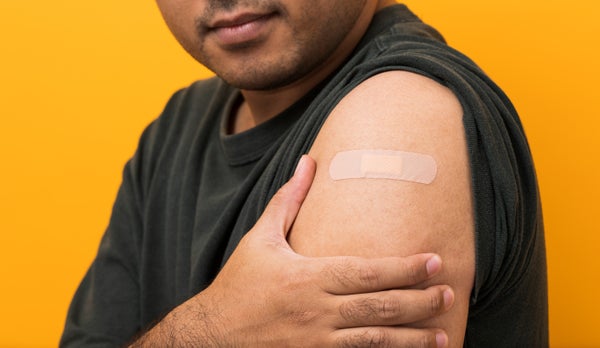Here we go again: respiratory virus season. For the first time this year, though, we have vaccines against our big three threats: flu, RSV and COVID. But vaccines in vials do not equal vaccinations in arms. Only 17 percent of Americans got last fall’s COVID vaccine. What do we do in a time of extreme fatigue, loss of trust, disinformation, politicization and lack of public health funds for education and outreach?
There is a solution. All of us—friends, family, neighbors, schools, pharmacies, doctor offices, health departments—need to be laser-focused on reaching a group called “passive positives.” These people have gotten COVID shots in the past and generally approve of vaccination. But they are unlikely to expend energy to find out where they can get another shot and are likely ambivalent about receiving one. They may feel good about the protection it confers but not so good about the prospect of side effects (yet again). Many of them are actively trying not to think about viruses this fall.
This is a large group—perhaps 35–40 percent of the vaccine-eligible population. Vaccinating such a large number of people could really reduce the number of serious COVID cases and deaths. Their approval of vaccines makes them good candidates; their passivity, however, makes them hard to motivate.
On supporting science journalism
If you're enjoying this article, consider supporting our award-winning journalism by subscribing. By purchasing a subscription you are helping to ensure the future of impactful stories about the discoveries and ideas shaping our world today.
One promising way to get passive positives to roll up their sleeves is a social psychology approach that comes from research aimed at increasing organ donation. (It’s called the “IIFF” model, which stands for Information, Immediate and complete registration, Focused engagement and Favorable activation.) Organ donation, like COVID vaccination, is rife with passive positives: people who approve of donation but have not signed up to be donors. To understand the components necessary to increase donor registration rates, social psychologists Jason Siegel, Eusebio Alvaro and Zachary Holman analyzed some interventions that were successful and others that were not.
A set of studies on organ donation sign-ups in New Mexico highlighted the critical role of providing information about registration qualifications. For instance, telling people they were not too old to register increased intent to donate. The importance of feelings in the moment was shown by a series of studies at motor vehicle departments, where people getting drivers licenses can check a box to sign up as organ donors. But visits to those agencies can be frustrating, and negative emotions can reduce people’s intentions to register as donors. The importance of an immediate and full chance to sign up was tested in a three-city investigation that found a fourfold increase in registrations when there was an opportunity to do so right then and there.
The fundamental key to success, researchers found, is that all components of this psychological strategy need to be present at the same time. Here’s how that approach can apply to a COVID vaccine push to reach passive positives.
First, people need to be reminded that they have good feelings about vaccines. Although people who have received some shots likely feel positive about vaccination, this group probably also has some negative feelings. Rather than thinking about lives saved, they think about people who have gotten sick despite vaccination. So a health care worker should actively encourage patients to focus on the benefits of vaccination.
Second, people need information about eligibility. Having three respiratory vaccines available at the same time can create confusion about optimal timing of the shots and how many you can get at once. For example, years ago, COVID shot eligibility varied across different ages and occupations. Now everyone aged six months and older is eligible for the fall vaccine thanks to clear CDC guidance. Yet passive positives are not inclined to search for this kind of information, lacking the motivation. So eligibility information must be given to them at every opportunity.
Third, health care workers need to remind patients about vaccines even during visits for other reasons. People are exhausted from more than three years of a pandemic; they likely now turn away rather than toward information about COVID and other viruses. So it helps, for instance, when doctors and pharmacists tell people that they can receive the fall shot right then.
Finally, and closely related to the previous point, if a person gets motivated, seize the chance. Their motivation is likely to be short-lived. It is critical to have a shot available the instant a person becomes interested in one.
Imagine a conversation with grandma that puts all these factors together. Next time you see her, remind her about all the positives of being up-to-date on COVID vaccinations, such as more confidence that seeing her grandkids won’t send her to the hospital. At the same time you can tell grandma that she is eligible to get the updated shot right now. Finally—and this is key—if she says OK, take her to get her shot right then.
This fall will require an all-hands-on-deck community approach to vaccinations. We do not have unrealistic expectations, though: a huge question is whether there is the will—or funding—to support an all-out effort to promote vaccine uptake. Many state and local governments are doing the best they can, but some are susceptible to external pressure—especially the political kind—that is actively discouraging everyone but the most at-risk from getting a vaccine this fall.
Despite these challenges, the approach we have outlined has a high chance of success. With just a little work, passive positives can be reached effectively. Fewer lives will be lost, fewer work and school days will be missed, and our quality of life will improve.
This is an opinion and analysis article, and the views expressed by the author or authors are not necessarily those of Scientific American.
